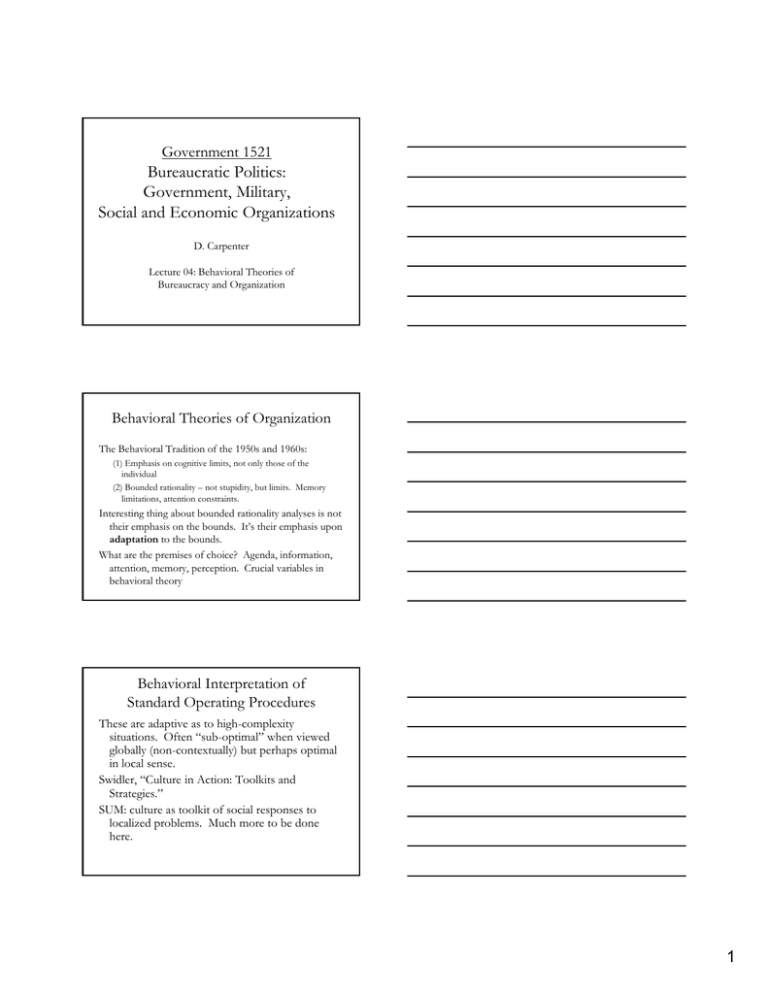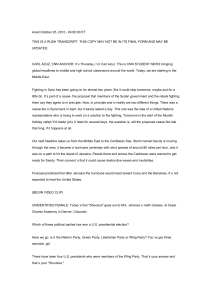Bureaucratic Politics: Government, Military, Social and Economic Organizations g
advertisement

Government 1521 Bureaucratic Politics: Government, Military, Social and Economic Organizations g D. Carpenter Lecture 04: Behavioral Theories of Bureaucracy and Organization Behavioral Theories of Organization The Behavioral Tradition of the 1950s and 1960s: (1) Emphasis on cognitive limits, not only those of the individual (2) Bounded rationality – not stupidity, but limits. Memory li i i limitations, attention i constraints. i Interesting thing about bounded rationality analyses is not their emphasis on the bounds. It’s their emphasis upon adaptation to the bounds. What are the premises of choice? Agenda, information, attention, memory, perception. Crucial variables in behavioral theory Behavioral Interpretation of Standard Operating Procedures These are adaptive as to high-complexity situations. Often “sub-optimal” when viewed globally (non-contextually) but perhaps optimal in local sense. Swidler, “Culture in Action: Toolkits and Strategies.” SUM: culture as toolkit of social responses to localized problems. Much more to be done here. 1 March & Simon: Satisficing and Search Organismal satisficing model (conceptually) [Organizations, 68] 1. 2. 3. 4. 5. The lower the satisfaction, the more search for alternative programs The higher the expected value of reward, the more search. The higher the expected value of reward, the higher the satisfaction, conditioned on receipt of the reward. BUT, the higher the expected value of reward, the higher the level of aspiration. HENCE, the higher the level of aspiration, the lower the satisfaction, ex post (after receiving reward). Muddling Through Lindblom’s message like Simon’s: High-level rationality not possible. Example: Decisionmaker charged with inflation policymaking. Instead of global optimization, “an alternative line of attack would be to set as his objective, either explicitly or without conscious thought, the relatively simple goal of keeping prices level.” [79] 2 Muddling Through Key feature in Lindblom’s model is costly reversibility of decisions: “Because practitioners of the second [incrementalist or branch] approach expect to achieve their goals only partially, they would expect to repeat endlessly the sequence just described, as conditions and aspirations changed and as accuracy of prediction improved.” [80] Incrementalism and Pluralism “Note, too, how the incremental pattern of policymaking fits with the multiple pressure pattern. For when decisions are only incremental – closely related to known policies, policies it is easier for one group to anticipate the kind of moves another might make and easier too for it to make correction for injury already accomplished.” [86] 3 Jones and Baumgartner: Disproportionate Information Processing Integrates incrementalism and broader theory of political choice. Combination of “over over-reaction reaction and under underreaction.” Most of the time, no reaction (high threshold.) But when reaction occurs, high level of reaction. Issues in punctuated equilibrium hypotheses. Steady state with historical “disruptions.” Jones and Baumgartner: Behavioral Model of Individual DM Recognition Stage Attend to aspects of the environmental that are potentially problematic Understand problems Prioritize these problems Decide which will be address now, which will be ignored now Characterization Stage Construct a “problem space” by determining the relevant attributes of a problem [the problem focused upon from the “recognition stage” Decide the weights of the attributes – which are most relevant (highest weight), which are less, which are irrelevant. Jones and Baumgartner: Behavioral Model of Individual DM Alternative Stage Given list of attributes from “characterization” stage, for each attribute consider alternative courses of action that might be useful Examine alternatives used in similar problems, recent problems Search for new alternatives Construct “solution spaces” to these problems consisting of the available alternatives; each attribute linked with one or more potential solutions or alternatives. Choice Stage Decide which alternative to choose Implement the favored alternative 4 Jones and Baumgartner: Premises of Choice Information/Signals – Has emotive content (“color”) – Ambiguous – Uncertainty not resolved [Key distinction: uncertainty v ambiguity.] Uncertainty: lack of knowledge. knowledge Only infinite data resolves this. this Probability of being wrong always positive with finite data. Ambiguity: Data subject to differing interpretations or perspectives. [Classic linguistic example: “Among the many leprechauns golfing that day, three of them were green.”] Other terms: “good.” “Undeletable” [impossible to delete, or possible to undelete?] Claim [NIE]: Iraq becoming “cause celebre” for terrorists. How to interpret? Jones and Baumgartner: Premises of Choice Attention: Constrained and Selective “Bottleneck” of short-term memory Induces competition: attend to issue X, then at some point, less attention to issue Y. Attention Constraints generate disproportionality: “delay, then over-react.” “…there is no one-to-one correspondence between the severity of problems in the decision-making environment and the policy responses of government. Information processing in politics is disproportionate; it is disjoint and episodic; it is stasis interrupted by bursts of innovation.” [20] Jones and Baumgartner: Cognition and Agenda-Setting “…policymakers are constantly bombarded with information of varying uncertainty and bias, not on a single matter, but on a multitude of potential policy topics. The process by which information is prioritized for action, and attention allocated to some problems rather than others, is called agenda-setting. Agenda setting can be viewed as a process by which a political system processes diverse incoming information streams.” [Politics of Attention, ix] 5 Alternative Distributions of Budget Change under Two Models of Incrementalism: Predicted Leptokurtosis GARBAGE CAN THEORY Derives from Cohen, March and Olsen article of 1972. Developed more conceptually in Kingdon, Agendas, Alternatives and Public Policies. See also Padgett, “Managing Garbage-Can Hierarchies” ASQ (1982) CAVEAT: Bendor, Bendor Moe and Shotts (2002) show that the computational model is wrong, and provide a critique. This makes Padgett more valuable and illustrative. Basic concept: organized anarchies. (1) Problematic preferences (2) Unclear technology (3) Fluid participation GARBAGE-CAN THEORY Basic notion: Orgs can be seen as (1) collections of choices looking for DMs, (2) collections of solutions looking for problems, (3) “issues and feelings looking for decision situations in which they might be aired,” (4) DMs looking for work. Related metaphor from Harrison White, Chains of Opportunity: Vacancy chain. 6 7 8






